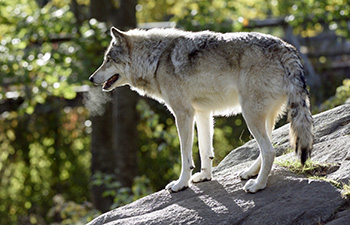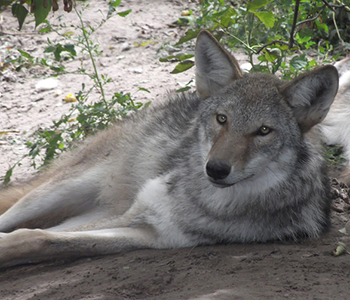A Call of the Wild Goes Out – Western Coyote and Eastern Wolf
By Site Ecology Team (SET) and Wildlife and Industry Together (WAIT)
March 17, 2015

Photo courtesy of Dawn Beattie
Coyote: “Where’re you from, Miss Wolf?”
Wolf: “Southern Canada around the Great Lakes. How about you?”
Coyote: “Oh, originally the Southwest, and American Great Plains. We were forced to move to the Great Lakes area, because hunters and farmers were killing us there.”
Wolf: “We’ve also lived in New York and the Northeast. Some of our Red Wolf kin lived in the Carolinas, but they too were hunted to extinction. The US Fish and Wildlife reintroduced fourteen red wolves from the Gulf States into North Carolina in 1987 and are trying to protect them, but we didn’t know any of them. Currently, the North Carolina Wildlife Resources Commission is trying to end the Red Wolf Reintroduction Program and let the red wolf become extinct again. They should be deciding pretty soon."

Photo courtesy of Bert de Tilly
Coyote: “Is it safe to go there now? Maybe we should wait. I’ve heard that they allow the hunting of coyotes at night and that no “canid” is safe. Is there a safe place we can stay?”
Wolf: “There’s a wolf protection area in North Carolina called the Alligator River National Wildlife Refuge. As long as we stay there we should be OK. This was the first Red Wolf reintroduction site.”
Coyote: “You want to go then? Would it be any safer than in Chicago, New York, or the Northeast?”
Wolf: “I’m willing if you are. We can follow the train tracks down.”
Coyote: “Listen, do you hear that, it could be our song” [Soundtrack]
“Let's get together, yeah yeah yeah.
Why don't you and I combine?
Let's get together, what do you say?
We can have a swinging time.
We'd be a crazy team.
Why don't we make a scene? Together.
oh, oh, oh, oh Let's get together, yeah yeah yeah.
Think of all that we could share.
Let's get together, everyday Every way and everywhere.
And though we haven't got a lot,
We could be sharing all we've got. Together.
And so begins the story and life of the “Coywolf” - a new Canid on the block!
By the 1960’s changes in the ecosystem, hunting pressure (predator control), habitat loss, poison usage, and pollution, had forced western coyotes out of their native ranges of the American Plains and southwestern deserts. They departed by either a northern route around the Great Lakes and through Canada, or a more southerly route below the Lakes toward the Mid-Atlantic States. One account has the coyotes using the I-70 bridge in St. Louis to cross the Mississippi River. Along the way, Coyotes encountered and bred with the native wolves. The northern animals moved eastward into the New England States. During this time the eastern wolf, or red wolf was suffering significant losses to man (hunting and vehicles). Coywolves continued their movement east and south, and began occupying the vacated red wolf niches.
T. Delene made the following observations: “Species within the Canis genus have a remarkable ability for crossing the species barrier and procreating under certain conditions. Dogs (Canis familiaris) can mate with some wolves (Canis lupus) [or coyotes (Canis latrans)] making a coydog. Wolves can mate with coyotes (Canis latrans) making a coywolf. And unlike other species that create infertile hybrids, the offspring of these pairings can be fertile, so when these hybrid offspring mate and produce their own pups, they introduce new genes into one of their parent populations. For example, when a coyote and a wolf mate and create a coywolf, and then that coywolf lands a coyote suitor and they have their own pups, those pups are born with some wolf genes that are then brought into the coyote population”. [Source]
If the suitor is wolf then conversely some coyote genes are brought into the wolf population. But what affect does hybrid mating have on the red wolf that is on the Endangered Species List? The red wolf is no longer a true red wolf. In the absence of eligible native wolf mates, and with the coyotes around, gene pool pollution increases the threat to red wolf recovery.
The U.S. Fish and Wildlife Service listed the red wolf as endangered in 1967, then extinct in the wild in 1980. In 1973 the Service initiated a captive breeding program, with over 400 wild canids being captured from the Gulf States. Only 10% of this stock was determined to be of pure red wolf stock. Fourteen of the captured animals were ultimately released into northeastern North Carolina in 1986. [Source]
What would be the concern if this gene pool mixing occurred? It has been noted, both with controlled cross breeding and in the wild, that phenotypic characteristics are observed. For instance, the hybrids/coywolf, when compared to the coyote: is larger (up to 40%), longer body and legs, bushier tail, smaller ears, larger jaws with greater bite pressure, exhibits greater pack behavior (rather than paired), is less wary of man, tends to adapt to urbanized areas, and is more aggressive, bolder and intelligent.
Besides the usual diet of small rodents, rabbits, birds, reptiles, the hybrid can now take larger prey (fox, deer, etc.) and that increases the risk that domesticated animals will fall victim to the coywolf. Coyote/coywolf bites are currently only a minor percentage of the canid inflicted bites yearly.
There are reportedly 20 subspecies of the southeastern coywolf, often indistinguishable by their physical traits; only by chromosomal analysis (micro-satellite and micro-array). Shat samples are often used to determine genotype and track migration patterns, as well as to determine contribution from dog, coyote, and/or wolf.

Photo courtesy of L. David Mech, Bruce W. Christensen, Cheryl S. Asa , Margaret Callahan, Julie K. Young
The coywolf is well documented in North Carolina, however, due to its nocturnal habits, it’s seldom observed by the general public. The Raleigh News and Observer recently ran an article by Larissa Lopez and Arielle Parsons documenting the result of placing motion cameras on a local Raleigh Greenway and monitoring animal activity throughout the day. They stated “Coyotes have been invading North Carolina since the mid-1980s and can now be found in all 100 counties”.
Some of the results during the day were expected (people, cats, dogs), but at night the mix changed to deer, foxes, coyotes, cats, raccoons, other nocturnal mammals. The authors state that “During a six-week period, the cameras “captured” 2,579 pictures of 13 species of wild mammals ...deer 46%, …grey fox 14%, …raccoon 14%, …cats 6%. Coyotes were 4.3% of the animal sightings at night, however, the authors didn’t distinguish between coyotes and coywolves.
It is advisable not to approach any predator or try to feed them. Even though the accounts are very rare, the coywolf can be dangerous, particularly if cornered. Do not put yourself at risk to get a close-up picture.
Informative and Entertaining YouTube Documentaries
- Interview with PBS Nature 2014 Wildlife Biologists, 9 mins
- Coywolf in northern Wake County, NC, 2014, 46 sec
- Coyote and Coywolf facts; Are Coyotes/Coywolves Dangerous? Keep it in Perspective: Coyotes vs. Dogs; How to avoid interactions from occurring; Do’s and Don’ts in Coyote Country
Sources



